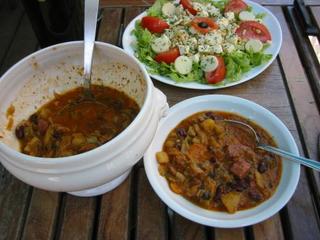Second Corse: Soup Corse, Dessert Corse
We had some good food in Corsica, but overall I was a bit disappointed; I was hoping for a blend of the best of French and Italian food, but the food, even when good, was less refined than either. Many dishes had a bachelor kind of feel -- maybe something to do with a history dominated by pirates and military garrisons....
Stuffed eggplant is the local specialty in Bonifacio, so GD and I both had it the first night in a nice-looking restaurant chosen at random, and it was a dissapointment. Under the flavorful, sweet-and-sourish tomato sauce (which later in the trip appeared in a rich risotto with liver sausage) were four tiny, hard, dried, shriveled things that used to be halves of a small eggplant, stuffed with something we couldn't taste. We couldn't believe any reputable place would mismanage the local specialty too badly, so we figured it was supposed to be that way, but I later saw (but didn't order) a plumper looking version in another place.
Another local specialty is polenta made with chestnut flour, but it's elusive. I ordered two stews which came with polenta but it was the ordinary corn kind; finally saw the chestnut one on a specials board we were walking past, but it wasn't mealtime. If I were a serious food blogger that wouldn't have stopped me, I suppose.

Soup Corse (shown above alongside a Salad of Pale Bland Things (hearts of palm, mozzarella, corn, pine nuts)) is much like minestrone -- vegetables and one or more kinds of beans -- with some pieces ham thrown in. We had two versions which were somewhat different, and both were different from the description in the guidebook. I liked it very much, and it reminded me a bit of the High-Trust Minestrone of my youth. You always get enough of it to fill you up even when you order it as a first course.

The fanciest main course we tried was this goose breast skewer with a fig and honey sauce. Try to imagine me seeing "fig and honey sauce" on a menu and not ordering it even when I had made a pledge 10 minutes earlier that we were going to just have a light lunch. Shown along side a "Cote D'Azur" salad.
I really, really wanted to like the cookies, tarts, and brioches. I wanted to like the fact that they were made with chestnut flour. But they all tended to be hard or mealy and dry and not very flavorful. I had dreamed of a repeat of Sicily and all the stuff with orange peel and marzipan. What I should have done was always have them with an aperitif or liqueur -- Corsica is the Land of the Aperitif and Liqueur, made from muscat grapes, or myrtle (a plant which makes bay leaves and blueberries), or chestnut (of course), or bitter citrus (cedrat = Hebrew etrog). How much of that is for tourists only I don't know; maybe the locals all drink pastis or wine or beer like everyone else.

His-and-hers beverages and matching glasses. Pietra beer is made with malt, hops, and ... chestnut flour.
Coming next: Toulouse redeems itself, food-wise.

2 Comments:
The identity of GD just dawned on me. A little slow! Hi, GD. Hope you enjoyed the trip.
"High-trust Minestrone" could only be named by a psychologist. A friend and colleague, Julian Rotter, was well-known for the "Trust Scale", a psychological test of ones tendency to trust people one did not know on first encounter without evidence one way or the other. I made soup to clean out the frig on occasion and asked that diners not ask what was in it but to act like someone who would test high on the trust scale and just eat it. It is related to "Cream-of-bottom-shelf soup," which I never did make, and to the Stone Soup of the Polish folk tale. Obviously no set recipe is involved -- just interpolate between what is maturing in the frig and a minestrone recipe in any standard cookbook. Even better, find a vegetable soup that claims to be French. Everything I make ends up tasting French no matter where I start.
Were there glace chestnuts? Myrtle liquor? Didn't you have that in US once? That is not the same plant that is growning as ground cover in our front yard, what the Brits call "periwinkle."
Now I know what pastis is.
http://frenchfood.about.com/cs/horsdoeuvres/a/pastis.htm
Post a Comment
<< Home